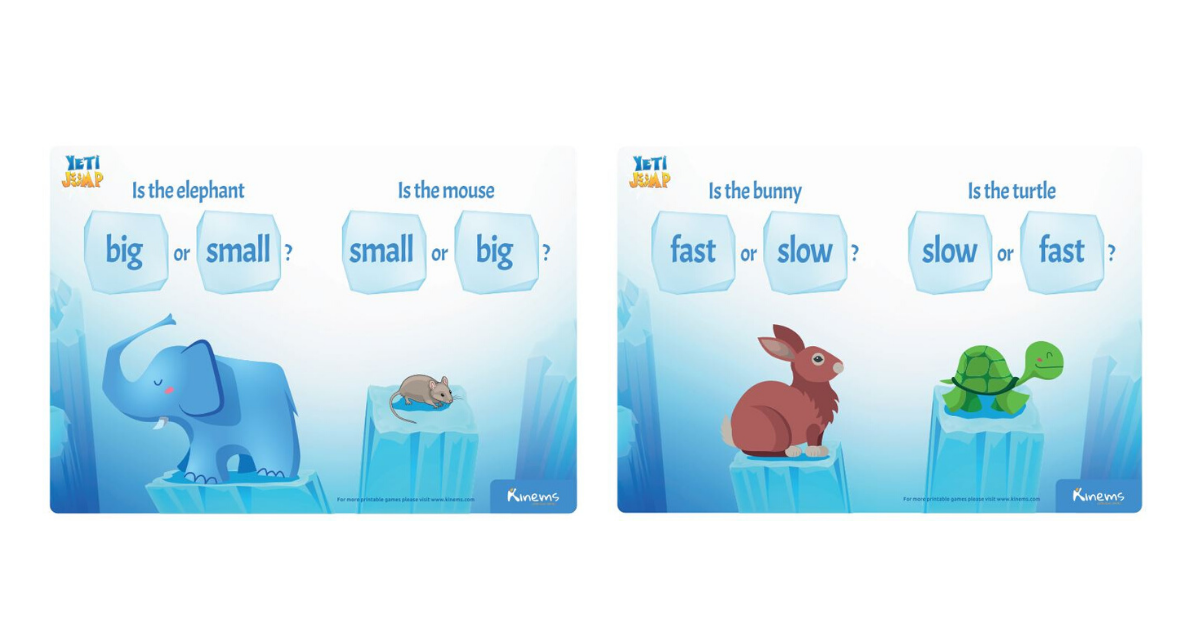Free Printable Board Game for Kindergarten Students | Yeti Jump

Yeti jump is an ideal game for students to practice identifying the opposite or antonym word!
The pictures on the pages offer images with meanings or characteristics that are opposites. This game offers a vocabulary experience in understanding attributes, while it promotes problem solving and critical thinking.
Most of the images offer adjectives describing an attribute of a noun in order to modify or describe it. For example: “is the rock hard or soft?” Some of the images offer adverbs which modify verbs in a similar way. For example: “the dolphin jumps high or low?”.

Besides practice in learning vocabulary and parts of speech, this experience offers a math goal for the Kindergarten level:
“Directly compare two objects with a measurable attribute in common, to see which object has "more of"/"less of" the attribute, and describe the difference. For example, directly compare the heights of two children and describe one child as taller/shorter.”
To play, take one sheet at a time and read the question. The child puts the Yeti cut out creature on the correct answer. You can have them walk in the direction that is correct and jump like a Yeti to “break” the ice cube and set free the image of the person, place or thing.
Relational Bridge Thinking Map
Another great thing you can do is make a relational bridge thinking map. Thinking maps are used by teachers to help children organize their thoughts. So this is a good way to introduce attributes. Basically, you are reviewing how the attribute relates to the person, place or thing described.
The relational or bridge thinking map looks like this:

On the top line goes the item and under is the relating factor. In this case the relating factor is the “attribute” that describes or modifies the item.

You don’t need a template to do this. It is better if you can teach your child to make the thinking map on paper and fill it in themselves.
You can use the thinking map to represent numbers also. You can hash tag or make dots on the top and write the numeral on the bottom. In that case the relating factor is numerical value. You could put one yeti creature above and write the numeral “1” below, put two Yeti characters in the next spot and write “2” below and so on.
You can use color as the relating factor. If you cut out the images after you have used the game, you can place an image on top and write the name of the color below OR use a crayon of the same color to color below the image.
These thinking maps can be saved to review the relational concepts.
Learning relationships early leads to critical thinking skills that will provide a strong foundation for the future. For example, college entrance exams provide many relational questions (at higher more abstract levels of course). But the basic skill of discovering relationships is a valuable building block for your young child.
Thinking Map Scavenger Hunt
Go on a hunt to find objects in your home or outdoors to describe. Collect the objects first, bring them to a table or floor and go through each object to come up with descriptions of their attributes. Make a thinking map!
Making predictions based on attributes
Get a paper bag and put in an object without showing what it is. Use a small car or crayon or pen or figurine. Your kids can’t look inside, but they can put their hands in and feel the object. They need to describe it to you. You can ask questions like: Is it hard? Does it have wheels? Can you squeeze it? And so on. Then ask them to guess what object it is. Have them put an object in a bag for you to feel and guess. Have them ask the questions for you to answer.
Get out a simple book with characters
Ask about what attribute each character has that is different from other characters. If there are more than one character in the book, compare the character attributes. For example, with the Tortoise and Hare, the Hare is fast and the Tortoise is slow. Make a relational map based on the character characteristics.
Use the Yeti creatures for counting and having fun!
Print out and cut out to use as counters. If you printed the numerals from the Who’s Counting board games, you can use those resources with the Yeti creatures to reinforce number sense. Download Yeti Jump Board Game